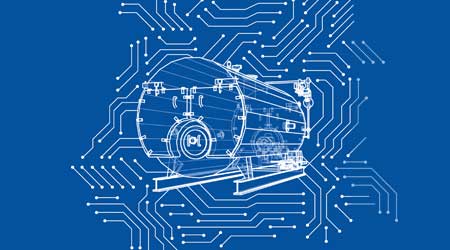Sensors, Better Communication Tech Mean Better Data for Boilers
Sophisticated building automation protocols and descriptive analytics are moving boilers into the 21st century.
The open network landscape has been changing quickly. Wireless communication and easy connectivity to the internet, along with plummeting prices for sensors and related electronic gear, have vastly expanded the potential to be in constant communication with literally every device in a building, passing information to the cloud or maintaining it inside of a local area network. This is the basis of the Building Internet of Things (B-IoT). This capability has increased the amount of data available to the point where it is unmanageable by most facility staff. Too much data is overwhelming, and the answer from software engineers has been to put together programs designed to compile, analyze, report, and even act on this massive amount of information. This augmented intelligence software is very much a work in progress, but in its early days it looks very promising, with great promise for effective management of building operations and maintenance.
Many people use the term artificial intelligence to describe systems that automatically sort through masses of unstructured information; however, some experts explain that the processing engines currently being used are still too dependent on human and B-IoT middleware intervention to be called true artificial intelligence, so it is more accurate to classify these algorithms as augmenting (under supervision) the decision making of human operators.
Most BAS use descriptive analytics to detail what has happened in a building. More advanced systems can use predictive analytics to determine what might happen in the future. The great leap with artificial intelligence will be in the successful implementation of prescriptive analytics, where the system automatically makes adjustments without direct human intervention.
A new era
The more progressive boiler manufacturers have embraced B-IoT and augmented intelligence, developing impressive products that are available right now. A great feature of many B-IoT-enabled controls is that they can be used without the need to route data through a larger BAS network. Communication goes back and forth from the boiler control, through the internet, to a smartphone, tablet or computer — almost plug and play. These products should be very appealing to the owners of smaller buildings. Most have multiple security functions with encrypted internet connectivity to the boiler control through the cloud.
Unfortunately, the B-IoT and augmented intelligence also present opportunity for calamity, through malicious hacking and other security risks, as well as the possibility of software doing something it shouldn’t do (as seen recently in other industries).
Internet security issues have been well addressed by most boiler manufacturers that are wading into that arena, but some don’t seem to appreciate the dangers. Building owners need to contemplate the havoc that might ensue if the wrong persons are able to dial up a boiler on their smartphone and start messing with it. It is important to perform risk analyses to see where vulnerabilities might lie. Have someone in the organization, or an outside consultant with an up-to-date understanding of cybersecurity, look at the whole picture before committing to a particular product.
Pay close attention to the software terms of use agreements. You may not want to give up all rights to the data your building systems produce, but many of these agreements give the control manufacturer or its service provider ownership of all of the data produced and stored, and allows them do as they please with it (within normal privacy protocol).
Boiler manufacturers for their part need to hire knowledgeable sales engineers who can sit down with building owners and facility managers and their IT staff, and dig into their needs and in-house capabilities to come up with a tailored solution.
It is not unusual for the simplest of internet-capable boiler control manuals to run over 100 pages. It will take some time for staff to read through and understand how these things work, and it is essential to specify that the manufacturer take part in the training and commissioning process. For each implementation of larger networked systems, organizations are likely going to need some degree of training for every level of its operation, from the CEO to the janitor, not just the maintenance and facility management staff. More sophisticated, larger BAS systems using B-IoT and augmented intelligence will absolutely require manufacturer training and commissioning sessions, and detailed training of key staff will be necessary if building owners want to avoid the ongoing expense of calling in an outside specialist any time an adjustment needs to be made.
Outside consulting fees, programming, and troubleshooting charges can add up very quickly, so it’s essential to analyze what services might be required, what these services will cost, and to what billing account they will be charged. Maintenance managers are never pleased to learn that a software code writer is burning through their budget in order to get a newfangled control system running properly. This can be a major source of push-back from maintenance personnel when upgraded systems are proposed – and can get serious when those managers feel they will lack the knowledge to control their own equipment.
Related Topics:















